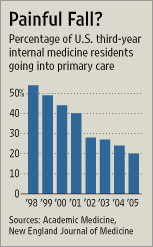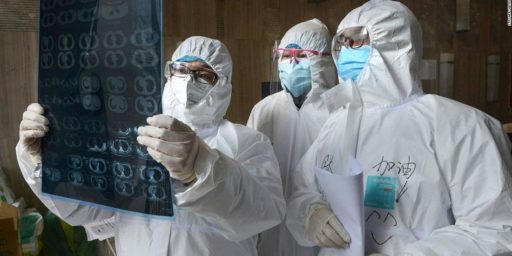Taking Power Away From Doctors Makes Medical Care More Efficient
In, "Squeezing out the doctor," The Economist looks at the future of medicine and sees a declining role for physicians.
In, “Squeezing out the doctor,” The Economist looks at the future of medicine and sees a declining role for physicians.
The past 150 years have been a golden age for doctors. In some ways, their job is much as it has been for millennia: they examine patients, diagnose their ailments and try to make them better. Since the mid-19th century, however, they have enjoyed new eminence. The rise of doctors’ associations and medical schools helped separate doctors from quacks. Licensing and prescribing laws enshrined their status. And as understanding, technology and technique evolved, doctors became more effective, able to diagnose consistently, treat effectively and advise on public-health interventions—such as hygiene and vaccination—that actually worked.
This has brought rewards. In developed countries, excluding America, doctors with no speciality earn about twice the income of the average worker, according to McKinsey, a consultancy. America’s specialist doctors earn ten times America’s average wage. A medical degree is a universal badge of respectability. Others make a living. Doctors save lives, too.
With the 21st century certain to see soaring demand for health care, the doctors’ star might seem in the ascendant still. By 2030, 22% of people in the OECD club of rich countries will be 65 or older, nearly double the share in 1990. China will catch up just six years later. About half of American adults already have a chronic condition, such as diabetes or hypertension, and as the world becomes richer the diseases of the rich spread farther. In the slums of Calcutta, infectious diseases claim the young; for middle-aged adults, heart disease and cancer are the most common killers. Last year the United Nations held a summit on health (only the second in its history) that gave warning about the rising toll of chronic disease worldwide.
But this demand for health care looks unlikely to be met by doctors in the way the past century’s was. For one thing, to treat the 21st century’s problems with a 20th-century approach to health care would require an impossible number of doctors. For another, caring for chronic conditions is not what doctors are best at. For both these reasons doctors look set to become much less central to health care—a process which, in some places, has already started.
[…]
One approach to making doctors more efficient is to focus what they do. India is home to some of the world’s most exciting models along this line, argues Nicolaus Henke of McKinsey, who leads the consultancy’s work with health systems. Britain has 27.4 doctors for every 10,000 patients. India has just six. With so few doctors, it is changing the way it uses them.
Your correspondent recently watched Devi Shetty, chief executive of Narayana Hrudayalaya hospital in Bangalore, making careful incisions in a yellowed heart, pulling out clots that resembled tiny octopuses. It looked difficult. Some of the other tasks at Narayana Hrudayalaya hospital do not, and are not. Dr Shetty’s goal is to offer as many surgeries as possible, without compromising on quality. To do that, he ensures that his surgeons do only the most complex procedures; an army of other workers do everything else. The result is surgeries that cost less than $2,000 each, about one-fifteenth as much as a similar procedure in America.
The trick is repeated in other areas of health care. India’s LifeSpring hospitals slash the price of childbirth by augmenting doctors with less expensive midwives. The costs are about one-sixth of those in a private clinic. The Aravind Eye Care System offers surgery to about 350,000 patients a year. Operating rooms have at least two beds, so surgeons can swivel from one patient to the next. Most important, for every surgeon there are six “eye-care technicians”—young women recruited and trained by Aravind—who perform the myriad tasks in the operating room that do not require a surgeon’s training.
Other problems have inspired other solutions, with technology filling gaps in the labour force. The Bill and Melinda Gates Foundation supports a programme that uses mobile phones to deliver advice and reminders to pregnant women in Ghana. In December the foundation and Grand Challenges Canada, a non-profit organisation, announced $32m in grants for new mobile tools that will help health-care workers diagnose various ailments. In Mexico, worried patients can phone Medicall Home, a “telehealth” service. If a patient needs care, Medicall Home can help to arrange a doctor’s visit. But about two-thirds of patients’ concerns can be addressed over the phone by a doctor (often one only recently qualified).
Such efficiencies have long since been adopted in other fields, so it’s only natural that they be applied to medicine. Lobbying by physicians’ groups has stymied a lot of this innovation in the United States but the economics will win out. And one would think physicians themselves would prefer to spend as much of their time as possible doing work that truly requires their expertise and delegating more mundane tasks to physician assistants, nurses, and technicians.







The federal government is actually moving the other way in the ramping up of credentials. Physical Therapy has moved to a PhD model. X-ray techs now needs a bachelors degree in many areas.
Since the U.S. now requires specialty training to be able to be reimbursed for certain medical procedures. Do you really think that the government is doing to make it easier for people with much less credentials to be able to bill for a procedure.
Dr.’s are a bunch of rent-seeking hacks.
Insurance Companies are more of the above. I spend more on insurance than I do on taxes. And for what?
I’m a conservative in that I prefer to work within established systems and traditions…as the PPACA does. But when it comes to health care…I say burn the whole thing down.
@Hey Norm: We’ve managed to create a system that’s the worst of all world: someone else is paying for most people’s care, so there’s no incentive to keep costs down, yet there are enough gaps that we lack universal coverage and people can get bankrupted by a medical crisis.
@ James…
And it doesn’t help that one of the political parties runs around saying it’s the best sytem in the world…and with just a little tort reform all would be well.
And…oh yeah…DEATH PANELS!!!!
Admitting you have a problem is the first step…
One of the best (and shortest) books I’ve ever read was Lewis Thomas’ “Lives of a Cell”. It was a collection of essays about life from his viewpoint as a post WWII and from his earlier viewpoint as the son of a horse and buggy doctor. One of the things that stuck in my mind was his contention that the less we know about any disease the more ability that doctors (and quacks) have in pulling money from peoples wallets. He pointed out that this was true for centuries, probably millennia. (Now that I think of it, it may have been in one of his later collections. But they are all short and well worth reading…)
The concept of a team-based approach to health care with each member of the team working at the height of their license/skills is coming, and in many places has already arrived, in this country. The most wide-spread is the Patient-Centered Medical Home model for primary care but you also see it in specialty areas like orthopedics and cardiology where you have enough volume in specific procedures to develop trained support staff to augment the physicians and handle most of the patient interactions.
The bonus is that, when properly implemented, the quality of care is typically much higher as is patient satisfaction as they have actual meaningful interactions with professional staff – as opposed to a rushed 8-10 minute exchange with an overworked and frustrated physician.
If power is taken away from the MDietys will liability also follow?
@James Joyner: I agree with you to the point that I object to you calling it a “system”. The term implies a level of organization and planning that is not present. It’s a collection of independent actors, not a “system”.
@gVOR08:
I almost said the same thing. Our “system” does suck, and will likely continue to suck despite the ACA reform. In part, it’s because it’s not really a system.
A couple of years ago, a poster on another site basically said this:
You either go full free market, or you go full socialized medicine. This split the difference nonsense stinks.
I can’t shake the feeling that he was correct.
@Rob in CT:
It’s not nonsense; most of the world has managed to do it. Purely socialized medicine–the model where government runs the hospitals and doctors are civil servants–is pretty awful, although probably an improvement over what we have for all but the wealthiest/best insured. But most Western countries have a baseline single payer system with private supplemental coverage. The numbers say that such a system is both radically cheaper and delivers superior outcomes than ours.
It’s hard to make this India:USA comparison when the former has a severe doctor:population ratio of 1:1700, while the latter is only at 1:390. India has no choice but to be more efficient simply because they don’t have enough doctors to treat their extremely large and impoverished population.
Interestingly, China has a much more manageable ratio of 1:950, because even though they have more people than India, they’ve managed to train more doctors both in and out of their country. Why India has so few trained doctors is a separate and interesting topic on it’s own.